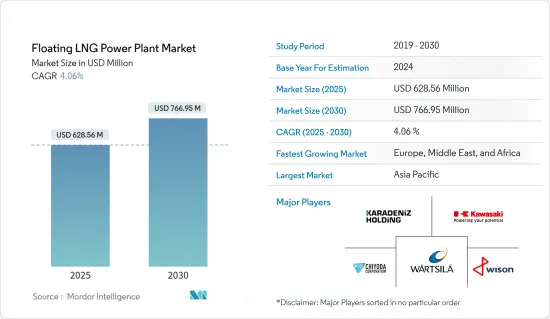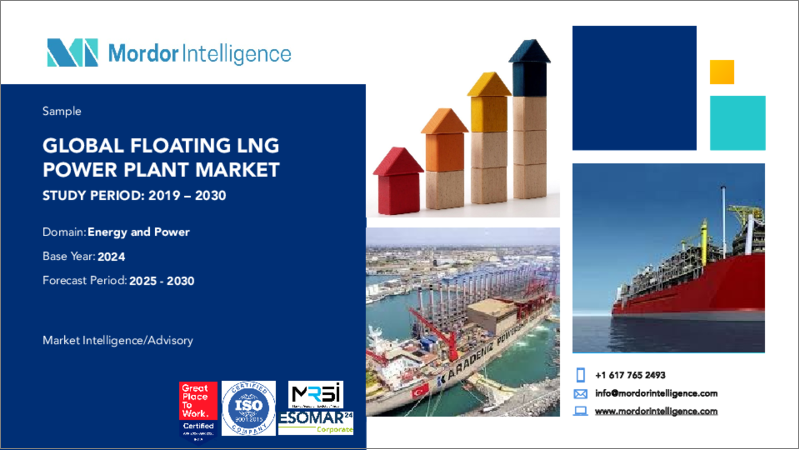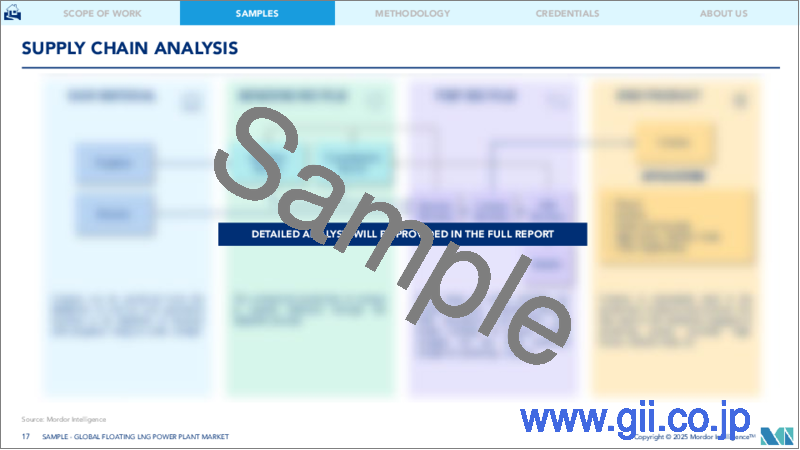|
|
市場調査レポート
商品コード
1690134
浮体式LNG発電所:市場シェア分析、産業動向・統計、成長予測(2025年~2030年)Floating LNG Power Plant - Market Share Analysis, Industry Trends & Statistics, Growth Forecasts (2025 - 2030) |
||||||
カスタマイズ可能
適宜更新あり
|
|||||||
| 浮体式LNG発電所:市場シェア分析、産業動向・統計、成長予測(2025年~2030年) |
|
出版日: 2025年03月18日
発行: Mordor Intelligence
ページ情報: 英文 125 Pages
納期: 2~3営業日
|
全表示
- 概要
- 目次
浮体式LNG発電所の市場規模は、2025年に6億2,856万米ドルと推計され、予測期間(2025-2030年)のCAGRは4.06%で、2030年には7億6,695万米ドルに達すると予測されます。

長期的には、人口増加による電力需要の増加や新興諸国における適切な電力インフラの不足といった要因が、浮体式LNG発電所市場を牽引すると予想されます。
一方、LNG価格の変動が激しく、ばらつきがあることが浮体式LNG発電所市場を抑制すると予想されます。
とはいえ、世界の排ガス規制により、LNGの採用は今後増加すると予想されます。LNGは比較的クリーンな燃料であり、排ガス規制をクリアしています。2020年にはIMOによる海上燃料の硫黄含有量削減が施行され、バンカー燃料としてのLNGの採用が進むとみられます。西アフリカのオフショアでも石油・ガス活動が活発化しており、FLNG発電所市場にもビジネスチャンスがもたらされると思われます。
アジア太平洋は最近大きな市場シェアを占めており、予測期間中は最大かつ最速の市場になると予想されます。
浮体式LNG発電所市場の動向
市場を独占すると予想されるパワーバージセグメント
- パワーバージは、平らな浮体構造物に設置される発電施設です。電力船とは異なり、バージにはある場所から別の場所へ移動するための自走システムがないため、バージの生産コストが削減されます。
- パワーバージには自走式移動システムがないため、他の小型ボートや船で移動します。バージ船の推進エンジンから節約されたスペースは、船内のより多くの使用可能なスペースに使用されます。
- 発電のための設備投資額が低い国や、インフラの利用可能性が低い国では、浮体式LNGベースの発電所の設置が増加しているため、パワーバージ市場は今後数年で大きく成長すると推定されます。
- さらに、「世界エネルギー統計2023」によると、天然ガスによる発電量は、2010年の約4883.80TWh、2015年の5635.95TWhから、2022年には6631.39TWhに達します。
- パワーバージには、FLNG発電分野での採用に拍車をかけるいくつかの利点があります。これらのバージ船は、輸送コストの低いバルク輸送に使用され、さまざまなサイズがあります。これらのバージ船は、低潮の海を移動することができ、エネルギーを生産し、浮遊しながら、あらゆる種類の貨物の輸送を成功させることができます。
- バージ船は特定の水域用に設計されており、そのバージ船は生涯その水域でしか走ることができないです。もしそのバージが別の水域で使用されるなら、適切にタグボートで曳航されるか、補助される必要があります。
- 2022年6月、エクセラレート・エナジー社は、欧州の国々で発電し、送電網を増強する浮体式発電所用の電力バージを供給すると発表しました。同社はまた、エクソンモービル社とともにアルバニアのヴローラ港でLNG-to-Powerプロジェクトを開発しています。
- 以上のことから、予測期間中、浮体式LNG発電所市場は、電力バージ船部門が支配的となることが予想されます。
アジア太平洋地域が市場を独占する見込み
- アジア太平洋地域では、エネルギー需給ギャップは石炭、水力、天然ガス、原子力、再生可能エネルギー技術などによって緩和されることが多いです。電力へのアクセスは、ほとんどの経済圏でかなりの割合で達成されています。一方、再生可能エネルギー源は、電力の信頼性問題を最大限に解消しており、この地域における浮体式LNG発電所市場の開拓の可能性は低いことを示しています。
- しかし、東南アジアでは、エネルギー供給を確保するために浮体式発電所を採用している国は少ないです。マレーシアのエネルギー当局によると、電力需要は2039年には約24GWに達すると予想されています。増大する需要に対応するため、政府は浮体式LNG発電所のようなエネルギー・システムの規模拡大策を講じています。
- 2023年、ペトロナスはKejuruteraan Asastera(KAB)と契約し、5,220万米ドル相当の52MWの浮体式LNG発電所を開発・試運転することになりました。浮体式LNG発電所はサバ州に設置されます。開発作業は2023年第2四半期に開始される予定です。また、スリランカ政府はアジア開発銀行と共同で、2022年に浮体式LNG発電所のフィージビリティ・スタディを実施することに合意しました。
- さらに2022年、インドネシアはLNGで動くように設計された浮体式発電船を受領し、同国の発電需要の橋渡しをすることになりそうです。BMPP Nusantara-1は、国内の遠く離れた地域の電力需要を満たす可能性を秘めており、企業や住民がレンタル発電バージへの依存を最小限に抑えるのに役立つと思われます。
- 以上のことから、予測期間中、アジア太平洋地域が浮体式LNG発電所市場を独占すると予想されます。
浮体式LNG発電所産業の概要
浮体式LNG発電所市場は適度に統合されています。市場の主要企業(順不同)には、Wison Group、Kawasaki Heavy Industries Ltd、Wartsila Oyj Abp、Chiyoda Corp、Karadeniz Holding.などが含まれます。
その他の特典:
- エクセル形式の市場予測(ME)シート
- 3ヶ月間のアナリスト・サポート
目次
第1章 イントロダクション
- 調査範囲
- 市場の定義
- 調査の前提
第2章 エグゼクティブサマリー
第3章 調査手法
第4章 市場概要
- イントロダクション
- 2029年までの市場規模および需要予測(単位:米ドル)
- 最近の動向と開発
- 政府の規制と政策
- 市場力学
- 促進要因
- エネルギー源としてのLNG利用の増加
- 抑制要因
- 太陽エネルギーと風力エネルギーの採用増加
- 促進要因
- サプライチェーン分析
- ポーターのファイブフォース分析
- 供給企業の交渉力
- 消費者の交渉力
- 新規参入業者の脅威
- 代替品の脅威
- 競争企業間の敵対関係
第5章 市場セグメンテーション
- コンポーネントタイプ
- ガスエンジンまたはガスタービン
- ICエンジン
- 蒸気タービン・発電機
- 船舶タイプ
- 動力船
- パワーバージ
- 地域
- 北米
- 米国
- カナダ
- その他北米
- 欧州
- ドイツ
- 英国
- フランス
- スペイン
- イタリア
- 北欧諸国
- トルコ
- ロシア
- その他欧州
- アジア太平洋
- 中国
- インド
- 日本
- 韓国
- マレーシア
- タイ
- インドネシア
- ベトナム
- その他アジア太平洋地域
- 南米
- ブラジル
- アルゼンチン
- コロンビア
- その他南米
- 中東・アフリカ
- サウジアラビア
- アラブ首長国連邦
- 南アフリカ
- ナイジェリア
- カタール
- エジプト
- その他中東とアフリカ
- 北米
第6章 競合情勢
- 合併、買収、提携、合弁事業
- 主要企業の戦略
- 企業プロファイル
- Kawasaki Heavy Industries Ltd.
- Wartsila Oyj Abp
- Siemens Energy AG
- Waller Marine Inc.
- Wison Group
- Chiyoda Corporation
- Karadeniz Holding
- Market Ranking/Share Analysis
第7章 市場機会と今後の動向
- ハイブリッド発電機の使用が浮体式LNG発電市場に大きな機会をもたらす
The Floating LNG Power Plant Market size is estimated at USD 628.56 million in 2025, and is expected to reach USD 766.95 million by 2030, at a CAGR of 4.06% during the forecast period (2025-2030).

Over the long term, factors such as increasing demand for power due to increasing population and the lack of proper power infrastructures in developing countries are expected to drive the floating LNG power plant market.
On the other hand, high volatility and uneven LNG prices are expected to restrain the floating LNG power plant market.
Nevertheless, LNG adoption is expected to increase in the future owing to global emission norms. LNG, being a comparatively cleaner fuel, fulfills emission regulations. In 2020, IMO's reduced sulfur content in maritime fuel came into force, which is likely to result in the adoption of LNG as a bunker fuel. Offshore West Africa is also seeing increased oil and gas activity that, in turn, will present opportunities in the FLNG power plant market as well.
Asia-Pacific held a significant market share recently, and it is expected to be the largest and fastest market during the forecast period.
Floating LNG Power Plant Market Trends
Power Barge Segment Expected to Dominate the Market
- A power barge is a power plant facility installed on flat floating structures. Unlike power ships, a barge doesn't have a self-propelled system for moving from one location to the other, which cuts the cost of production for barges.
- As these power barges do not have any self-propelled moving systems, they are moved by other small boats or ships. The space saved from the propulsion engines in barges is used for more usable space in the vessel.
- The market for power barge is estimated to grow significantly in upcoming years due to the increasing installation of floating LNG-based power plants in countries with lower CAPEX for power generation or by countries having lower infrastructure availability.
- Moreover, as per the Statistical Review of World Energy 2023, the electricity generation from natural gas reached 6631.39 TWh in 2022 from around 4883.80 TWh in 2010 and 5635.95 TWh in 2015.
- Power barges have several advantages that fuel their adoption across the FLNG power generation segment. These are used to transport bulk with lower transportation costs, and they are available in different sizes. These barges can travel in low-tide water, and they can facilitate successful transportation of any sort of cargo while producing energy and floating.
- The barge is designed to carry out for a specific water body, and that barge can only run in that water body throughout its life. If that barge is used in some different water body, then it needs to be properly tugged or assisted by a tugboat.
- In June 2022, ExcelerateEnergy Inc. announced to supply power barge for floating power plants that will generate electricity and buoy the grid in the European nation. The company is also developing an LNG-to-Power project together with Exxon Mobil Corp. in the Albanian port of Vlora.
- Hence, owing to the above points, the power barge segment is expected to dominate the floating LNG power plant market during the forecast period.
Asia-Pacific Expected to Dominate the Market
- In the Asia-Pacific region, the supply-demand energy gap is often mitigated by sources such as coal, hydro, natural gas, nuclear, and renewable energy technologies. A significant rate of electricity access has been achieved in most of the economies. On the other hand, renewable energy sources have eradicated power reliability issues to the maximum extent, which indicates low chances for the development of a floating LNG power plants market in the region.
- However, few countries in Southeast Asia have adopted floating power plants to secure energy supplies. According to Malaysia's energy authority, the electricity demand is expected to reach about 24 GW in 2039. To cater to the growing demand, the government has taken measures to scale up energy systems, such as floating LNG power plants, to fulfill the same.
- In 2023, Petronas contracted Kejuruteraan Asastera(KAB) to develop and commission a 52MW floating LNG power plant worth USD 52.2 million. The floating LNG power plant would be located at Sabah. The development work is expected to start in the second quarter of 2023. Also, the Sri Lankan government, in association with the Asian Development Bank, agreed to conduct a feasibility study in 2022 on a floating LNG power plant, which could help the country diversify its energy mix.
- Further, in 2022, Indonesia received a floating power barge designed to run on LNG, which is likely to bridge the power generation requirements in the country. BMPP Nusantara-1 holds the potential to fulfill the electricity demand of far-flung areas of the country, which would help businesses and residents minimize their dependence on rented power generation barges.
- Hence, owing to the above points, Asia-Pacific is expected to dominate the floating LNG power plant market during the forecast period.
Floating LNG Power Plant Industry Overview
The floating LNG power plant market is moderately consolidated. Some of the key players in the market (in no particular order) include Wison Group, Kawasaki Heavy Industries Ltd, Wartsila Oyj Abp, Chiyoda Corp, and Karadeniz Holding., among others.
Additional Benefits:
- The market estimate (ME) sheet in Excel format
- 3 months of analyst support
TABLE OF CONTENTS
1 INTRODUCTION
- 1.1 Scope of the Study
- 1.2 Market Definition
- 1.3 Study Assumptions
2 EXECUTIVE SUMMARY
3 RESEARCH METHODOLOGY
4 MARKET OVERVIEW
- 4.1 Introduction
- 4.2 Market Size and Demand Forecast in USD, till 2029
- 4.3 Recent Trends and Developments
- 4.4 Government Policies and Regulations
- 4.5 Market Dynamics
- 4.5.1 Drivers
- 4.5.1.1 An Increase in the Use of LNG as an Energy Source
- 4.5.2 Restraints
- 4.5.2.1 Increasing Adoption of Solar and Wind Energy
- 4.5.1 Drivers
- 4.6 Supply Chain Analysis
- 4.7 Porter's Five Forces Analysis
- 4.7.1 Bargaining Power of Suppliers
- 4.7.2 Bargaining Power of Consumers
- 4.7.3 Threat of New Entrants
- 4.7.4 Threat of Substitutes Products and Services
- 4.7.5 Intensity of Competitive Rivalry
5 MARKET SEGMENTATION
- 5.1 Component Type
- 5.1.1 Gas Engines or Gas Turbines
- 5.1.2 IC Engines
- 5.1.3 Steam Turbines & Generators
- 5.2 Vessel Type
- 5.2.1 Power Ship
- 5.2.2 Power Barge
- 5.3 Geography
- 5.3.1 North America
- 5.3.1.1 United States
- 5.3.1.2 Canada
- 5.3.1.3 Rest of North America
- 5.3.2 Europe
- 5.3.2.1 Germany
- 5.3.2.2 United Kingdom
- 5.3.2.3 France
- 5.3.2.4 Spain
- 5.3.2.5 Italy
- 5.3.2.6 Nordic Countries
- 5.3.2.7 Turkey
- 5.3.2.8 Russia
- 5.3.2.9 Rest of Europe
- 5.3.3 Asia-Pacific
- 5.3.3.1 China
- 5.3.3.2 India
- 5.3.3.3 Japan
- 5.3.3.4 South Korea
- 5.3.3.5 Malaysis
- 5.3.3.6 Thailand
- 5.3.3.7 Indonesia
- 5.3.3.8 Vietnam
- 5.3.3.9 Rest of Asia-Pacific
- 5.3.4 South America
- 5.3.4.1 Brazil
- 5.3.4.2 Argentina
- 5.3.4.3 Colombia
- 5.3.4.4 Rest of South America
- 5.3.5 Middle East & Africa
- 5.3.5.1 Saudi Arabia
- 5.3.5.2 United Arab Emirates
- 5.3.5.3 South Africa
- 5.3.5.4 Nigeria
- 5.3.5.5 Qatar
- 5.3.5.6 Egypt
- 5.3.5.7 Rest of Middle East & Africa
- 5.3.1 North America
6 COMPETITIVE LANDSCAPE
- 6.1 Mergers, Acquisitions, Collaboration and Joint Ventures
- 6.2 Strategies Adopted by Key Players
- 6.3 Company Profiles
- 6.3.1 Kawasaki Heavy Industries Ltd.
- 6.3.2 Wartsila Oyj Abp
- 6.3.3 Siemens Energy AG
- 6.3.4 Waller Marine Inc.
- 6.3.5 Wison Group
- 6.3.6 Chiyoda Corporation
- 6.3.7 Karadeniz Holding
- 6.4 Market Ranking/Share Analysis
7 MARKET OPPORTUNITIES AND FUTURE TRENDS
- 7.1 Usage Of Hybrid Gensets Provides A Significant Opportunity for the Floating LNG Power Market





